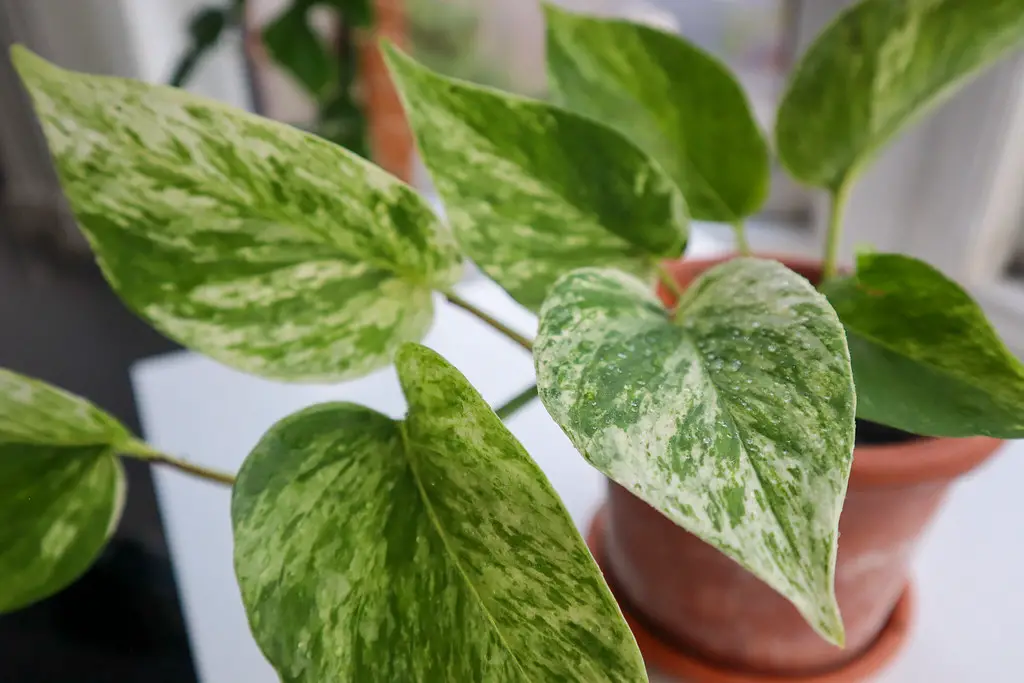Marble Queen Pothos, known for its attractive variegated leaves, is a popular and easily maintained houseplant. With a mix of green and creamy white, the glossy heart-shaped leaves add charm to any interior space. A variant of the Golden Pothos, Marble Queen is appreciated for its aesthetic appeal as well as its hardy nature, which makes it suitable for beginner gardeners.
A native of the Solomon Islands, Marble Queen Pothos is not only admired for its ornamental value but is also considered an effective air-purifying plant. NASA’s Clean Air Study lists Pothos among the top indoor plants for removing common household toxins, contributing to a healthier living environment.
Marble Queen’s adaptability, resilience, and eye-catching appearance have contributed to its reputation as a beloved houseplant. But, like all plants, it thrives best under specific care and conditions. Below, we’ll explore the Marble Queen’s characteristics and care needs.
| Attribute | Details |
|---|---|
| Common Names | Marble Queen Pothos, Devil’s Ivy |
| Botanical Name | Epipremnum aureum ‘Marble Queen’ |
| Family | Araceae |
| Plant Type | Evergreen vine |
| Mature Size | Up to 10 feet long |
| Sun Exposure | Low to bright, indirect light |
| Soil Type | Well-draining soil |
| Hardiness Zones | 10-11 |
| Native Area | Solomon Islands |
Marble Queen Pothos Care
Caring for Marble Queen Pothos is straightforward, even for those new to gardening. The plant’s adaptability to a wide range of light conditions and its tolerance for various watering regimes make it particularly resilient. However, careful attention to its specific needs can help this striking plant thrive and flourish.
The Marble Queen requires a balanced approach to watering, light, and feeding. Its variegated leaves, although beautiful, make it slightly more demanding than the more common Golden Pothos. With proper care, though, it can be a long-lasting and healthy addition to any home or office.
Light Requirement for Marble Queen Pothos
This plant prefers low to bright, indirect light. Direct sunlight can cause the leaves to become pale or scorched. Providing filtered light will help maintain the distinctive variegation in the leaves.
Soil Requirements for Marble Queen Pothos
A well-draining potting mix with organic matter works best for Marble Queen Pothos. Too dense or heavy soil can lead to root rot, so ensuring proper drainage is crucial.
Water Requirements for Marble Queen Pothos
Marble Queen Pothos likes to be kept consistently moist but not soggy. Overwatering can lead to root rot, while underwatering may cause the leaves to wilt. Checking the soil’s moisture and allowing it to dry slightly between watering is key.
Temperature and Humidity
Thriving in temperatures between 65°F and 80°F, Marble Queen Pothos also appreciates moderate humidity. If the air is too dry, misting the leaves or using a humidifier can maintain the optimal environment.
Fertilizer
Fertilizing with a balanced, water-soluble fertilizer every 6-8 weeks during the growing season supports healthy growth. Avoid over-fertilizing, as this can cause the loss of variegation.
Pruning Marble Queen Pothos
Regular pruning helps control the length and promotes a bushier appearance. Removing dead or yellowing leaves keeps the plant looking vibrant.
Propagating Marble Queen Pothos
Propagation is typically done through stem cuttings placed in water or soil. It is a simple and effective way to multiply this beautiful plant.
How To Grow Marble Queen Pothos From Seed
Growing Marble Queen Pothos from seed is not commonly practiced, as it can be challenging and time-consuming. Propagation through cuttings is generally preferred.
Common Pests & Plant Diseases
Mealybugs
Prevent by regular inspection and treat with insecticidal soap if infested.
Root Rot
Avoid overwatering and ensure well-draining soil to prevent this condition.
Common Problems With Marble Queen Pothos
Loss of Variegation
This can occur due to too much direct sunlight or over-fertilization.
Leaf Yellowing
Often a sign of overwatering or poor quality water with high mineral content.
Pro Tips
- Rotate the plant regularly to ensure even growth.
- Use filtered or de-chlorinated water for best results.
- Avoid placing the plant near drafts or heaters.
- Clean leaves with a damp cloth to maintain shine and monitor for pests.
- Be patient with growth; variegated varieties like Marble Queen grow slower than their non-variegated counterparts.




